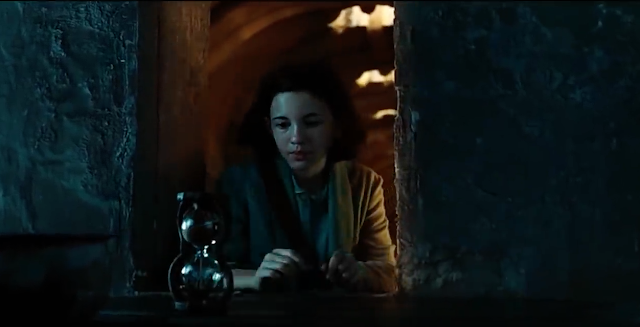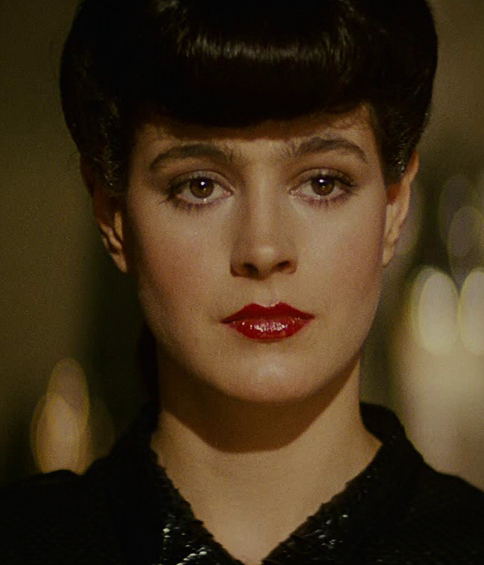Pan's Labyrinth: The Pale Man Scene
Guillermo Del Toro's "Pan's Labyrinth" contains a scene in which Ofelia visits The Pale Man. The first shot is a tracking back extra long shot, in which the mise-en-scene is brighter and golden in colour. This shows the audience that the fantasy world is a brighter and less harsh place compared with the darker blander reality. The shot is filmed with a one point perspective which causes the effect of a long hallway which juxtaposes that of the little girl. This makes Ofelia seem smaller than she is and makes the new magical world seem large and grande. The mise-en-scene also has the effect of causing the audience to doubt the safety of the world because the pillars have connotations of overpowering strength and therefore means that we are scared for Ofelia.

Then a few shots later the juxtaposition between the two worlds is highlighted by the mid shot showing Ofelia leaving reality behind. The mise-en-scene of the dark grey walls, that look grimy and dirty, represent the harsh conditions of the Spanish civil war and, are the complete opposite of the bright and colourful realm that awaits her. The sand timer reminds the audience that there is very little time for Ofelia to complete her task and this mirrors the fact that the rebels in the forest have very little time to survive because the fascists are closing in. The fact Ofelia is looking at the timer emphasises the fact that the timer will be important in the fantasy foreshadowing the time running out, which also mirrors the time running out for the freedom fighters.
The mid shot from behind showing the pale man's feast is both bright and dark in colour, this shows the two sides to the fantasy world, the more exciting, bright, almost safe appearance which is encompassed by a circle of darkness which represents the darker harsher reality of the fantasy world. This represents fascist Italy in 1944, An apparently settled country that once the surface is scratched reveals a viscous heartless rule in which many are persecuted, for having different views. The mise-en-scene highlights the advantages that the leaders of the fascist Italy have because the feast layed out in front of the pale man is meant to remind the audience of the earlier banquet scene in which Vidal was eating with the senior figures in the area, the clergy included. As Vidal is meant to symbolise Franco and his regime, the shot invokes the sense of hypocrisy and imbalance that was rife in 1944 Spain because it shows the rich having beautiful, golden food on gleaming platters, whilst the country suffered. The anti fascist message is further enhanced by the mise-en-scene of the fire behind the pale man, because fire has connotations of danger and also of hell, meaning that Del Toro wanted to relate the pale man to the devil and by doing so show that the fascist regime is evil as well, from who the pale man represents. By making the pale man represent Vidal and Franco, Ofelia is then made to not only mirror the actions of Mercedes showing more similarities, looking at the feast but not being allowed to have any food, but she represents the whole of the oppressed society, the people who Franco rations out food to, the people who cant speak out about their suffering because of fear of murder. The fact that she is placed on one half of the screen and he is on the other highlights the divide in the fascist society, because those in charge , The pale man, have light above them and a feast layed out ,with so much food they cant eat it all, and the ordinary working people, Ofelia, who have no light above them and no luxuries to gorge themselves on.
The tracking mid shot that follows emphasises the wealth and the privilege of the fascist leaders as it shows the luxurious feast that is spread out in front of the Pale Man. As this shot tracks Ofelia to the Pale Man we realise that he hasn't got any eyes in his head, which could symbolise the fact that the fascist regime was wilfully blind to the suffering as it was easier to just see the great feasts and pleasures that the privileged receive. This is supported by the mise-en-scene of the eyes on the table. The eyes are placed in such a way that it is only possible to see the feast and not the darkness and hostility that surrounds the scene. The darkness adds to the tone of danger as well as representing the poverty and harsh reality of Franco's Spain. The fact that the Pale Man is extremely vile looking, a monster, shows the links between the fascists and fairy tale monsters, this linking back to classic traits of a fairy take and showing how effectively Del Toro has merged the historical genre with that of the fairy tale, to the extent where there are two monsters that we think about in this scene, The Pale man and Vidal. By merging the two Del Toro proves to the audience that there aren't only monsters in the fantasy world they are in reality too.
Following is two Shot reverse shots firstly showing Ofelia looking at a close up of The Pale Man, which emphasises how horrifying the figure is, and in return also shows the horrifying nature of fascism. The next reverse is more interesting as it allows us to see the mise-en-scene on the ceiling.
The horrific drawings of The Pale Man massacring children, highlights that to gain power or at least to keep it the pale man has murdered innocent people, these murals tell us that the fascists have killed anyone in there way not caring about there age, gender or guilt. Because of the shot reverse shot, we know that Ofelia is looking at these paintings of death, which allows us to feel scared for her because The Pale Man has killed children before, meaning she isn't safe, it almost foreshadows the attempt on her life at the end of the scene.





Comments
Post a Comment